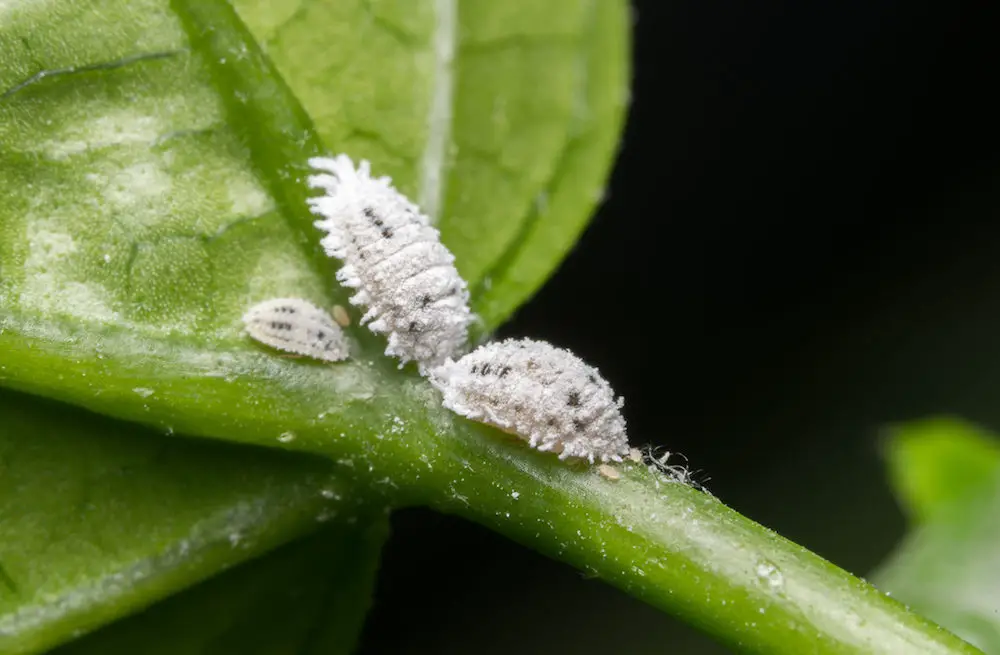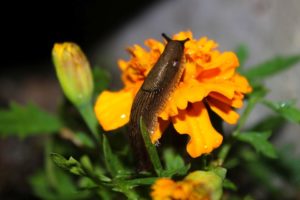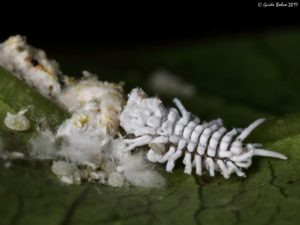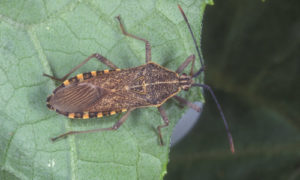Many people associate mealybugs with indoor plants. However, these small pests, which are related to scales and whiteflies, can also be found living outdoors in colonies on ornamental and vegetable plants where they can do significant damage by feeding on the sap. Their honeydew secretions add additional woes because it attracts ants and promotes black sooty mold.
How to Identify Mealybugs
Adult mealybugs measure between 1/10″ to 1/4″ long, and their segmented, oval bodies have fringe-like hairs around the perimeter. They are covered with a white or gray wax that looks like ground meal, hence their name. They produce a cotton-like substance that keeps them from drying out from the heat, and it offers protection for the eggs they lay. Nymphs are pale pink, yellow, or orange and are not covered in wax.
Female mealybugs are usually the ones observed on plants, while the males, which are gnat-sized and have wings, go unnoticed. The females are wingless and move about by crawling, although only for short distances.
Mealybugs prefer warm, humid weather, but they also live in cooler climates where they are more active during the warmer months.
There are hundreds of species of mealybugs,[1] however, the two most common ones are the longtailed mealybug, so named because it has two tails that are as long or longer than its body, and the citrus mealybug, which usually causes the most damage. Both species have short filaments around the perimeter of their bodies.
Mealybugs are often confused with the larvae of the mealybug destroyer, a beneficial bug that, as its name suggests, kills mealybugs. Both insects have white, oval bodies, but the mealybug destroyer larvae has thicker, woolly-like filaments covering its body, whereas mealybugs have filaments only along the perimeter of its body. Also, mealybug destroyer larvae are 1/2″ long, about twice the size of adult mealybugs, and they are much more active.
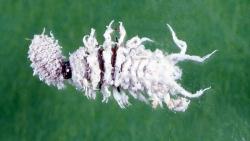
Where to Look for Mealybugs
Mealybugs love greenhouses because of the warmth and humidity they provide, but they also feel right at home on plants in your garden. Look for them on new growth as they are particularly fond of tender plant tissue. They can also be found hiding in the joints of stems, as well as under leaves, or in any nook and cranny they can find. They like fruit trees, as well as tropical and subtropical plants, but they can also live on a wide variety of ornamental and vegetable plants.
Life Cycle
Female mealybugs lay between 100 and 600 hundred yellow eggs, depending on the species, in white, cotton-looking excretions over a two to three week period. After depositing the eggs, the female mealybug will die. Pale yellow, pink, or orange nymphs will emerge about ten days later. They are referred to as crawlers as they travel over the plant in search of a safe place to begin feeding. They are more mobile than female adult mealybugs who, once they’ve found a place to eat feed, will move very little.
It takes between three and sixteen days for the eggs to hatch, depending on the species, and several more weeks for the nymphs to develop into adult mealybugs. The eggs of longtailed mealybugs, on the other hand, hatch almost immediately, giving the appearance of live births instead of hatching eggs. Some varieties of mealybugs can reproduce asexually.
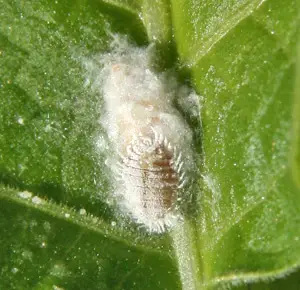
The nymphs will not produce a waxy coating until they have begun eating. Male nymphs will secrete a cotton-looking cocoon of sorts where they will remain while they develop wings. They will then fly off in search of females to mate. The males have a short life-span of only a few days.
Mealybugs will overwinter as eggs or in the nymph stage in plants where there was an infestation. Once temperatures increase, like leaf-footed bugs and other insects that overwinter, they will become active.
Damage
Both nymph and adult stages can cause damage to host plants by piercing plant tissue with their needle-like stylets, which act like straws enabling them to suck out the plant’s sap. Sap loss weakens the plant and results in yellowing leaves, leaf drop, flower bud drop, fruit drop, wilt, and eventually the death of the plant. When mealybugs feed, they inject their saliva into the plant, which contains a toxin that can cause plant malformation and even the death of some plants if there is a large infestation.
Mealybugs also excrete a sticky residue referred to as honeydew that, like the honeydew of aphids, attracts ants. In turn, the ants protect the mealybugs from predators and will actually carry the mealybugs to new plants, thus spreading the infestation. The sticky honeydew can promote black sooty mold that, if left unchecked, can prohibit photosynthesis and can stunt the plant’s growth.
This article contains affiliate links. If you make a purchase using one of these links I will receive a very small commission at no additional cost to you, and it will help me maintain this website. Rest assured, I only recommend products I actually like!
How to Get Rid of Mealy Bugs Organically
1. Water Pressure
Mealybugs can only go one day without eating before they die. By dislodging them from the host plant with a steady stream of pressurized water, these slow-moving insects will more than likely be unable to reestablish themselves on a host plant before they die.
2. Pruning
Prune off any leaves or branches that are heavily infested.
3. Rubbing Alcohol
Use a cotton swab to apply isopropyl alcohol, also known as 70% rubbing alcohol, directly to the mealybugs. You will need to reapply every week until the bugs are gone.
If there are too many mealybugs to treat them individually, you can add one cup of isopropyl alcohol to one quart of water in a spray bottle. Be sure to do a test spray on a leaf first. After 24-48 hours, if the leaf is not adversely affected, you can spray the rest of the plant with the solution. You’ll want to spray the topsoil around the plant as well since some species live in the soil. (Do not water the plant with the spray.) Repeat every week until there are no more mealybugs.
4. Homemade Insecticidal Soap
Insecticidal soap can be an effective way to get rid of mealybugs because the soap is able to penetrate the protective wax that covers the bugs.
You can make your own insecticidal soap by adding one teaspoon of Castile soap (or other chemical-free soap) like Dr. Bonner’s or Dr. Wood’s, to a one quart spray bottle filled with water. Mix well. Always do a test spray on one leaf and wait 24-48 hours to see if there are any adverse reactions. Then spray the plant thoroughly. Repeat every week until there are no more mealybug. Remember not to spray during the day as it could burn your plants.
5. Neem Oil Spray
Neem oil is derived from the seeds of the neem tree, an evergreen from India and Southeast Asia. Choose a pure, cold-pressed neem oil that contains Azadirachtin, a naturally occurring compound that makes the oil more effective. It works well on a many troublesome insects including, squash bugs, squash vine borers, aphids, whiteflies, and mealybugs.
Neem acts in several ways to eliminate insects. It acts as an antifeedant and a hormone disrupter, preventing nymphs from developing. It also serves to disrupt the adult mealybug’s ability to reproduce. According to the University of Connecticut, neem oil can penetrate the nymph’s soft body, killing it by suffocation. [2] It can also act as a repellent.
Make your own spray by mixing 1-2 teaspoons of pure, cold-pressed neem oil (this is the one I use) containing Azadirachtin, with 1/2 teaspoon of Castile soap like Dr. Bonner’s or Dr. Wood’s, and 1 quart of water. Shake well. Do a spray test on a leaf and wait 24 to 48 hours to see results before spraying the rest of the plant. Repeat every week if needed until the mealybugs and eggs are gone. Do not spray during the day as the combination of sun and oil could burn your plants.
6. Introduce Predators
You can purchase beneficial insects such as ladybugs, parasitic wasps, green and brown lacewing larvae (also known as aphid lions), and mealybug destroyers, which is a type of ladybug, to hunt down and kill mealybugs in your garden. The downside to this type of treatment is that it can take time. Thus, you might want to plan to introduce beneficial insects before seasons when you generally experience infestations. Garden spiders can also help keep insect populations down. You’ll also want to take measures to eliminate ants since they protect the mealybugs from predators.
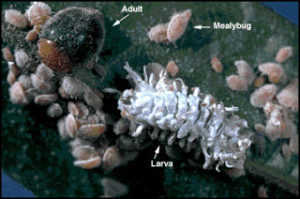
How to Prevent Mealy Bugs
1. Inspect Your Garden Regularly
As they say, the best defense is a good offense. Get in the habit of inspecting your garden regularly. You’d be surprised at how much garden “drama” you can avoid by being proactive.
2. Use Proper Amounts of Fertilizer
Refrain from over-fertilizing your plants. High levels of nitrogen in your soil will stimulate tender new plant growth, which will attract mealybugs. Fertilize only when necessary according to established guidelines.
3. Use Proper Watering Techniques
Don’t over-water your plants as mealybugs thrive in warm, humid, and moist environments.
4. Inspect New Plant Additions
Before adding any new transplants to your garden, inspect them thoroughly for mealybug eggs, nymphs and adults. This will help minimize the chances of someone else’s mealybug problem becoming your own. Continue to keep an eye on the new transplants as it may take a few weeks before any missed eggs hatch.
5. Do Not Reuse Soil From Infested Plant
If you grow in containers, refrain from using soil that came from a container where there was an infestation of mealybugs or other harmful insects. Be sure to wash a container that housed an infested plant thoroughly with a 10% bleach solution (i.e., 1 part bleach to 9 parts water) and rinse well. Refill with a fresh, a organic potting mix.
Mealybugs don’t have to spell disaster for your garden if you take preventative steps and implement effective control measures.
Note: If you found this article helpful, please share it with someone you think might be interested in it as well. Thank you!
[1] If you’d like to learn more about some of the more common varieties of mealybugs you can check out this link: https://content.ces.ncsu.edu/mealybugs
[2] University of Connecticut, Neem Based Insecticides, http://ipm.uconn.edu/documents/raw2/Neem%20Based%20Insecticides/Neem%20Based%20Insecticides.php?aid=152
